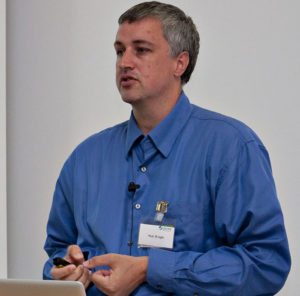In this video from the GPU Technology Conference, Nick Wright from Lawrence Berkeley Lab presents: Perlmutter: A 2020 Pre-Exascale GPU-accelerated System for NERSC – Architecture and Application Performance Optimization.
We’ll present an overview of the upcoming NERSC9 system architecture, throughput model, and application readiness efforts.”
Perlmutter, a Cray system based on the Shasta architecture, will be a heterogeneous system comprising both CPU-only and GPU-accelerated nodes, with a performance of more than 3 times Cori, NERSC’s current platform. It will include a number of innovations designed to meet the diverse computational and data analysis needs of NERSC’s user base and speed their scientific productivity.
The new system derives performance from advances in hardware and software, including a new Cray system interconnect, code-named Slingshot, which is designed for data-centric computing. Slingshot’s Ethernet compatibility, advanced adaptive routing, first-of-a-kind congestion control, and sophisticated quality of service capabilities improve system utilization and performance and scalability of supercomputing and AI applications and workflows.
The system will also feature NVIDIA GPUs with new Tensor Core technology, direct liquid cooling and will be NERSC’s first supercomputer with an all-flash scratch filesystem. Developed by Cray to accelerate I/O, the 30-petabyte Lustre filesystem will move data at a rate of more than 4 terabytes/sec.
Nick Wright is the advanced technologies group lead and the NERSC chief architect. He focuses upon evaluating future technologies for potential application in scientific computing. He led the effort to optimize the architecture of the Perlmutter machine, the first NERSC platform designed to meet needs of both large scale simulation and data analysis from experimental facilities. Before moving to NERSC, he was a member of the Performance Modeling and Characterization (PMaC) group at the San Diego Supercomputing Center. He earned both his undergraduate and doctoral degrees in chemistry at the University of Durham in England.
See more talks from the GPU Technology Conference
Check out our insideHPC Events Calendar





